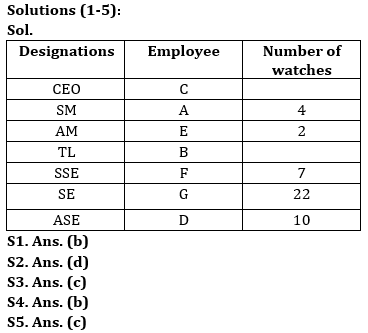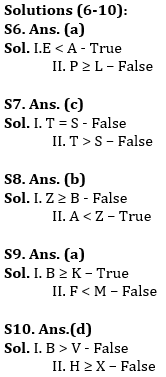Directions (1-5): Answer the questions based on the information given below.
Seven employees (A, B, C, D, E, F and G) of a company have different designations among- CEO, SM, AM, TL, SSE, SE and ASE, such that CEO is the senior most designation and ASE is the junior most designation. Five employees have different number (2, 4, 7, 10 and 22) of watches with them.
E who is AM, has 2 watches less than A. A is four designations senior to G. D who has 3 watches more than F, is junior than G. C is three designations senior to B. SM does not have odd number of watches. Difference between the number of watches of SE and ASE is more than 6.
Q1. Who is the CEO?
(a) A
(b) C
(c) F
(d) G
(e) None of these
Q2. How many persons are senior than F?
(a) One
(b) Two
(c) Three
(d) Four
(e) None of these
Q3. What is the sum of the number of watches of SM and SE?
(a) 14
(b) 24
(c) 26
(d) 29
(e) None of these
Q4. How many persons are senior than B?
(a) Four
(b) Three
(c) Five
(d) Six
(e) None of these
Q5. F and G are ___ and _____ respectively.
(a) SM, SSE
(b) AM, SE
(c) SSE, SE
(d) SE, ASE
(e) None of these
Directions (6-10): In the following questions, a statement(s) is given, followed by some conclusions. Study the following statements carefully and answer the questions accordingly.
Q6. Statements: P > D ≥ E = T ≤ S < L ≤ A
Conclusions: I.E < A
II.P ≥ L
(a) If only conclusion I follows
(b) If only conclusion II follows
(c) If either conclusion I or II follows
(d) If neither conclusion I nor II follows
(e) If both conclusions I and II follow
Q7. Statements: E = P > C ≥ D = S ≤ R < L ≤ A, T ≥ C > Z = N
Conclusions: I. T = S
II. T > S
(a) If only conclusion I follows
(b) If only conclusion II follows
(c) If either conclusion I or II follows
(d) If neither conclusion I nor II follows
(e) If both conclusions I and II follow
Q8. Statements: B = M < Q ≤ Z ≥ S = T, Q = I > A
Conclusions: I. Z ≥ B
II. A < Z
(a) If only conclusion I follows
(b) If only conclusion II follows
(c) If either conclusion I or II follows
(d) If neither conclusion I nor II follows
(e) If both conclusions I and II follow
Q9. Statements: Z > T ≥ F, B ≥ I ≥ J = K > Z > M > N
Conclusions: I. B ≥ K
II. F < M
(a) If only conclusion I follows
(b) If only conclusion II follows
(c) If either conclusion I or II follows
(d) If neither conclusion I nor II follows
(e) If both conclusions I and II follows
Q10. Statements: B = H ≥ V < W > X > Y > Z
Conclusions: I. B > V
II. H ≥ X
(a) If only conclusion I follows
(b) If only conclusion II follows
(c) If either conclusion I or II follows
(d) If neither conclusion I nor II follows
(e) If both conclusions I and II follows
Solutions







 General Awareness Quiz for Bank Mains Ex...
General Awareness Quiz for Bank Mains Ex...
 English Language Quiz For Bank Foundatio...
English Language Quiz For Bank Foundatio...
 Reasoning Quiz For Bank Foundation 2024 ...
Reasoning Quiz For Bank Foundation 2024 ...





